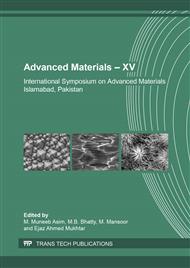[1]
N. Ueda, T. Omata, N. Hikuma, K. Ueda, H. Hizoquchi, T. Hashimoto, H. Kawazoe, New oxide phase with wide band gap and high electro-conductivity, MgIn2O4, Appl. Phys. Lett., 61 (1992) 1954-(1955).
DOI: 10.1063/1.108374
Google Scholar
[2]
R. Pandey, J.D. Gale, S.K. Sampath, J.M. Recio, Atomistic simulation study of spinel oxides: zinc aluminate and zinc gallate, J. Am. Ceram. Soc., 82 (1999) 3337–3341.
DOI: 10.1111/j.1151-2916.1999.tb02248.x
Google Scholar
[3]
J. Wrzyszcz, M. Zawadzki, J. Trawczyński, H. Grabowska, W. Miśta, Some catalytic properties of hydrothermally synthesised zinc aluminate spinel, Appl. Catalysis. A, 210 (2001) 263-269.
DOI: 10.1016/s0926-860x(00)00821-8
Google Scholar
[4]
S. Mathur, M. Veith, M. Haas, H. Shen, N. Lecerf, V. Huch, S. Hüfner, R. Haberkorn, H.P. Beck, M. Jilavi, Single-source sol–gel synthesis of nano-crystalline ZnAl2O4: structural and optical properties, J. Am. Ceram. Soc., 84 (2001) 1921–(1928).
DOI: 10.1111/j.1151-2916.2001.tb00938.x
Google Scholar
[5]
Y. Yang, X.W. Sun, B.K. Tay, J.X. Wang, Z.L. Dong, H.M. Fan, Twinned Zn2TiO4 spinel nanowires using ZnO nanowires as a template, Adv. Mater., 19 (2007) 1839–1844.
DOI: 10.1002/adma.200700299
Google Scholar
[6]
F. Le Pelier, P. Chaumette, J. Saussey, M.M. Bettahar, J.C. Lavalley, In-situ FT-IR spectroscopy and kinetic study of methanol synthesis from CO/H2 over ZnAl2O4 and Cu-ZnAl2O4 catalysts, Mol. Catal. A: Chem., 122 (1997) 131-139.
DOI: 10.1016/s1381-1169(97)00034-4
Google Scholar
[7]
L.R. Cobb, Preparation of Polymethylbenzenes, U.S. Patent 4.568.784, (1985).
Google Scholar
[8]
A. Escardino, J.L. Amorós, A. Gozalbo, M.J. Orts, A. Moreno, Gahnite devitrification in ceramic frits: mechanism and process kinetics. Journal of the American Ceramic Society, J. Am. Ceram. Soc., 83 (2000) 2938-2944.
DOI: 10.1111/j.1151-2916.2000.tb01664.x
Google Scholar
[9]
K. Kumar, K. Ramamoorthy, P.M. Koinkar, R. Chandramohan, K. Sankaranarayanan, A novel in situ synthesis and growth of ZnAl2O 4 thin films. J. Cryst. Grow. 289 (2006) 405-407.
DOI: 10.1016/j.jcrysgro.2005.11.007
Google Scholar
[10]
Y. Wang, K. Wu, As a Whole: Crystalline zinc aluminate nanotube array-nanonet, J. Am. Chem. Soc., 127 (2005) 9686–9687.
DOI: 10.1021/ja0505402
Google Scholar
[11]
A. Thomas, B. Premlal, M. Eswaramoorthy, Synthesis of mesoporous Zn–Al spinel oxide nanorods with membrane like morphology, Mater. Res. Bull., 41 (2006) 1008–1014.
DOI: 10.1016/j.materresbull.2006.03.025
Google Scholar
[12]
R. Mouazer, M. Persin, M. Cretin, A. Larbot A. Preparation and characterization of NASICON–ZnAl2O4-based ultrafiltration membranes, Colloids and Surfaces A: Physicochem. Eng. Aspects., 244 (2004) 95–104.
DOI: 10.1016/j.colsurfa.2004.06.005
Google Scholar
[13]
G. Aguilar-Rfos, M. Valenzuela, P. Salas, H. Armendfiriz, P. Bosch, G. Del Toro, R. Silva, V. Bertfn, S. Castillo, A. Ramfrez-Solfs, I. Schifter, Hydrogen interactions and catalytic properties of platinum-tin supported on zinc aluminate, Appl. Catal. A-Gen., 127 (1995).
DOI: 10.1016/0926-860x(95)00269-3
Google Scholar
[14]
E. Martinez-Sanchez, M. Garcia-Hipolito, J. Guzman, F. Ramos-Brito, J. Santoyo- Salazar, R. Martinez Martinez, O. Alvarez-Fregoso, M.I. Ramos-Cortes, J.J. Mendez-Delgado, C. Falcony, Cathodoluminescent characteristics of Sm doped ZnAl2O4 nanostructured powders, Phys. Stat. Sol., (a) 202 (2005).
DOI: 10.1002/pssa.200406906
Google Scholar
[15]
Y. Wu, J. Du, K.L. Choy, L.L. Hench, J. Guo, Formation of interconnected microstructural ZnAl2O4 films prepared by sol–gel method, Thin Solid Fil., 472 (2005) 150– 156.
DOI: 10.1016/j.tsf.2004.07.084
Google Scholar
[16]
A. R. Phani, M. Passacantando, S. Santucci, Synthesis and characterization of zinc aluminum oxide thin films by sol–gel technique, Mater. Chem. Phys., 68 (2001) 66–71.
DOI: 10.1016/s0254-0584(00)00270-4
Google Scholar
[17]
Z. Chen, E. Shi, Y. Zheng, W. Li, N. Wu, W. Zhong, W. Synthesis of monodispersed ZnAl2O4 powders under hydrothermal conditions, Mater. Lett., 56 (2002) 601– 605.
DOI: 10.1016/s0167-577x(02)00561-x
Google Scholar
[18]
M. Zawadzki, Synthesis of nanosized and microporous zinc aluminate spinel by microwave assisted hydrothermal method (microwave–hydrothermal synthesis of ZnAl2O4), Sol. Stat. Sci,. 8 (2006) 14–18.
DOI: 10.1002/chin.200614024
Google Scholar
[19]
H. Noor, H. Yousaf, M. A. Naseer, N. Iqbal, N. Tariq, S. Riaz and S. Naseem, Ball milling effect on structural, optical and dielectric properties of Y2O3, Proceedings of the International Conference on Sustainable Materials Science and Technology, 15-17 July 2015, Paris, France.
Google Scholar
[20]
A.F. Osorio, D.H. Mendoza, E.P. Villanueva, Synthesis of nano-crystalline (Zn1-xCox) Al2O3 solid solution: structural and optical properties, NSTI-Nanotech, 1 (2010) 448-451.
Google Scholar
[21]
E.M.A. Jamal, D.S. Kumar, M.R. Anantharaman, On structural, optical and dielectric properties of zinc aluminate nanoparticles, Bull. Mater. Sci., 34 (2011) 251-259.
DOI: 10.1007/s12034-011-0071-y
Google Scholar
[22]
S. Talam, S.R. Karumuri, N. Gunnam, Synthesis, Characterization and spectroscopic properties of ZnO nanoparticles, ISRN Nanotechnol., 2012 (2012) 1-7.
DOI: 10.5402/2012/372505
Google Scholar
[23]
V. Priiyawong, V. Thongpool, P. Asanithi, P. Limsuwan, Preparation and characterization of alumina nanoparticles in deionized water using laser ablation technique, J. Nanomater., 2012 (2012) 1-6.
DOI: 10.1155/2012/819403
Google Scholar
[24]
B.D. Culity, Elements of x-ray diffraction, Addison-Wesley Publishing Company, (1956).
Google Scholar
[25]
S. Neogi, U. Chowdhury, A.K. Chakraborty, J. Ghosh, Effect of mechanical milling on the structural and dielectric properties of BaTiO3 powders, Micro & Nano Lett., 10 (2015) 109-114.
DOI: 10.1049/mnl.2013.0751
Google Scholar
[26]
S. S. Kumbhar, M. A. Mahadik, P. K. Chougule, V. S. Mohite, Y. M. Hunge, K. Y. Rajpure, A. V. Moholkar, C. H. Bhosale, Structural and electrical properties of barium titanate (BaTiO3) thin films obtained by spray pyrolysis method, Mater. Sci.-Poland., 33 (2015).
DOI: 10.1515/msp-2015-0107
Google Scholar
[27]
K. W. Wagner, Zur theorie der unvollkommenen dielektrika, Annalen der Physik., 345 (1993), 817-855.
DOI: 10.1002/andp.19133450502
Google Scholar
[28]
E. Barsoukov, J. R. Macdonald, Theory, experiment and application, John Wiley & sons, Inc, (2005).
Google Scholar
[29]
Y. D. Kolekar, L. J. Sanchez, C. V. Ramana, Dielectric relaxations and alternating current conductivity in manganese substituted cobalt ferrite, J. Appl. Phys., 115 (2014) 144106-11.
DOI: 10.1063/1.4870232
Google Scholar


